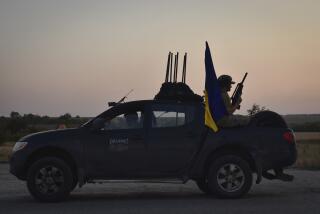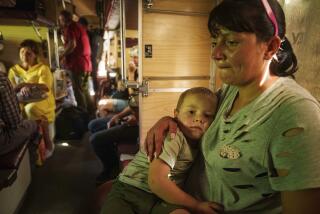Serb Forces Capture Key Crossroads Town : Bosnia: About 5,000 civilians and fighters flee Bosanski Brod, on Croatian border. The conquest opens way for the victors to build a Greater Serbia.
- Share via
BELGRADE, Yugoslavia — Rebel Serbs in Bosnia-Herzegovina finished capturing the strategic northern town of Bosanski Brod on Wednesday, giving them an unimpeded corridor to Serb-held territory in Croatia and most of the land they need to build a Greater Serbia from Yugoslavia’s ruins.
The conquest of Bosanski Brod and destruction of the last Bosnian bridge across the Sava River leave the few remaining Muslim and Croatian defenders of the city with no escape route or channel for reinforcements.
About 5,000 civilians and fighters fled across the bridge to relative safety in neighboring Croatia before the span was blown up early Wednesday, media reports said. Accounts conflicted as to which side destroyed the bridge linking Bosanski Brod with the Croatian city of Slavonski Brod.
Belgrade Radio boasted that “Croatian flags no longer fly” in the defeated city, although Croatian Radio reported that some forces were attempting to hold out against the Serbian onslaught. But even the Zagreb broadcast conceded Serbian control of the vital crossroads.
Bosanski Brod had stood in the way of Serbian access to the remote Krajina area, which was seized from Croatia last autumn and declared an autonomous Serbian region.
Hundreds of Croatian and Muslim fighters were killed in the final operation to take Bosanski Brod, a statement issued by the Bosnian Serbs claimed. It said the victory has “significantly lifted the morale and (shown) that the Serbs are invincible.”
But the Serbs’ fierce assault on the city further damaged the credibility of Radovan Karadzic, their chief warlord, who has repeatedly assured United Nations and European Community leaders at stalled negotiations in Geneva that his forces are ready for a peaceful settlement.
In an attempt to head off Western plans to impose a “no-fly” zone over Bosnia, Karadzic again assured the mediators on Wednesday that his rebels would refrain from deploying aircraft in the campaign in Bosnia, if Muslims and Croats accepted the status quo.
U.S. State Department spokesman Richard Boucher in Washington rejected Karadzic’s latest assurances, noting that the Bosnian Serbs vowed to ground their aircraft six weeks ago but that air attacks have continued.
The United States, Britain and France agreed Wednesday to propose imposition of the no-fly zone but without armed enforcement. No date has been set yet for consideration of the proposal by the U.N. Security Council.
Only Serbian forces have air power--thanks to the Yugoslav People’s Army, which “withdrew” in May but left at least 50 fighter planes, hundreds of tanks and huge stockpiles of heavy guns and ammunition in Serbian hands.
After taking Bosanski Brod, the rebels stepped up their offensives elsewhere in the nearly defeated republic.
As Serbian forces pounded the Bosnian capital of Sarajevo with artillery early Wednesday, Sarajevo Radio described the assault as “one of the most hellish mornings since the beginning of the war.”
Serbs opposed to Bosnia’s declared independence from Serb-run Yugoslavia also attacked the Muslim strongholds of Bihac and Gradacac with air and ground forces, and the Croatian-held city of Mostar also suffered renewed attack.
Serbs from Bosnia and their heavily armed patrons from Serbia now control about 70% of the territory of what was Bosnia-Herzegovina, a mountainous republic in which none of the three main ethnic groups--Muslim Slavs, Serbs and Croats--were a majority of its 4.4 million people.
The Serbs’ notorious practice of “ethnic cleansing” and concerted bombardment of Muslim and Croatian strongholds has driven 2 million people from their homes over the past six months, making the Serbs the majority now and unchallenged rulers of the vanquished lands.
Karadzic said repeatedly before the war began that he wanted to see what he considered to be Serbian territory in Bosnia linked up with the republic of Serbia and Serb-held areas of Croatia.
He has since denied that the rebels aspire to create an expanded Serbia, although the continued fighting in northern and western Bosnia appears aimed at securing a region stretching between Romania and the Adriatic Sea.
More than 24,000 people have been killed in Croatia and Bosnia-Herzegovina since the Yugoslav federation began its chaotic breakup more than a year ago.
Nearly 60,000 others are missing and feared dead.
Most of the casualties have been civilians.
International relief agencies fear as many as 400,000 could die this winter from starvation and cold.
Most of the Muslims and Croats still holding out against Serbian offensives have been forced into dilapidated communes with little food and no heat.
More to Read
Sign up for Essential California
The most important California stories and recommendations in your inbox every morning.
You may occasionally receive promotional content from the Los Angeles Times.














